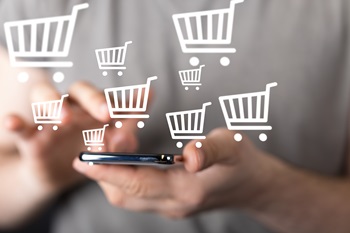By: Carol Abel, Vice President, Education Program Development, FMI
 The explosion of ecommerce has put greater emphasis on the grocery store experience. Ecommerce has become routine and expected but will not replace in-store shopping for all consumers. The physical store will continue to be important for shoppers in the future.
The explosion of ecommerce has put greater emphasis on the grocery store experience. Ecommerce has become routine and expected but will not replace in-store shopping for all consumers. The physical store will continue to be important for shoppers in the future.
Changes caused by ecommerce can increase sales from both in-store and online shoppers. The most visible sign of the growth of online shopping is the addition of staging areas in stores. Better use of backroom space and conversion of low traffic areas such as cafés and now closed service bars can minimize the disruption for in-store shoppers. Additionally, the squeeze on selling space often leads to SKU rationalization efforts and better assortment for all. Slower movers can be made available in ‘endless aisles’ through online shopping programs.
Supermarkets are seeing a rise in the number of third-party shoppers as well as the store’s own personal shoppers. Training programs for staff and effective communication with third-party shoppers is important to ensure that online order pickers and traditional shoppers co-exist peacefully. Communication regarding store policies is a good occasion to reaffirm the service culture.
Parking lots are taking on greater significance as shopping becomes more digital. Clean and well-kept lots have always been important, but these areas may be the only place to make a good impression with click and collect shoppers. Fresh striping, clear directionals and good signage are important for the safety of shoppers and are also a wonderful branding opportunity. This untapped real estate may now be a new venue for communicating key messages and promotional information to all shoppers.
As the labor market continues to tighten, store technology will play a greater role in the improving operational efficiency throughout the store. Robots that scan aisles for out of stocks and perpetual inventory programs will benefit both in-store and on-line shoppers by reducing out of stocks and improving inventory transparency. Micro fulfillment centers in backrooms will provide much needed automation and labor savings.
As retailers remodel existing stores and build new stores, ecommerce will be fully incorporated into store design and layout. Stores of the future are likely to be a hybrid model with on-line ordering for packaged goods and vibrant fresh departments that comprise the bulk of selling space. This format provides retailers the opportunity to showcase strengths – meat, produce and prepared foods - while achieving greater operational efficiency.
The 2022 FMI Energy & Store Development Conference will closely examine the advantages, opportunities and solutions in brick-and-mortar stores and the effects of the digitalization of commerce. Join the discussion September 19-21, 2022, in Orlando, FL. Register today.


 Industry Topics address your specific area of expertise with resources, reports, events and more.
Industry Topics address your specific area of expertise with resources, reports, events and more.
 Our Research covers consumer behavior and retail operation benchmarks so you can make informed business decisions.
Our Research covers consumer behavior and retail operation benchmarks so you can make informed business decisions.
 Events and Education including online and in-person help you advance your food retail career.
Events and Education including online and in-person help you advance your food retail career.
 Food Safety training, resources and guidance that help you create a company food safety culture.
Food Safety training, resources and guidance that help you create a company food safety culture.
 Government Affairs work — federal and state — on the latest food industry policy, regulatory and legislative issues.
Government Affairs work — federal and state — on the latest food industry policy, regulatory and legislative issues.
 Get Involved. From industry awards to newsletters and committees, these resources help you take advantage of your membership.
Get Involved. From industry awards to newsletters and committees, these resources help you take advantage of your membership.
 Best practices, guidance documents, infographics, signage and more for the food industry on the COVID-19 pandemic.
Best practices, guidance documents, infographics, signage and more for the food industry on the COVID-19 pandemic.
